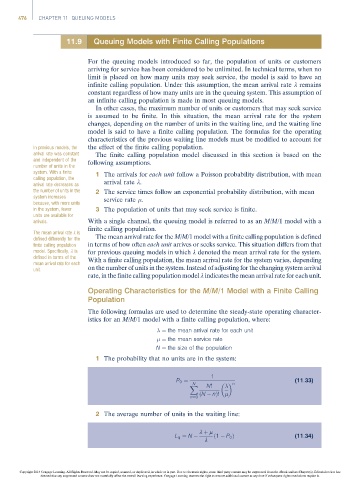Page 496 -
P. 496
476 CHAPTER 11 QUEUING MODELS
11.9 Queuing Models with Finite Calling Populations
For the queuing models introduced so far, the population of units or customers
arriving for service has been considered to be unlimited. In technical terms, when no
limit is placed on how many units may seek service, the model is said to have an
infinite calling population. Under this assumption, the mean arrival rate l remains
constant regardless of how many units are in the queuing system. This assumption of
an infinite calling population is made in most queuing models.
In other cases, the maximum number of units or customers that may seek service
is assumed to be finite. In this situation, the mean arrival rate for the system
changes, depending on the number of units in the waiting line, and the waiting line
model is said to have a finite calling population. The formulas for the operating
characteristics of the previous waiting line models must be modified to account for
In previous models, the the effect of the finite calling population.
arrival rate was constant The finite calling population model discussed in this section is based on the
and independent of the following assumptions.
number of units in the
system. With a finite 1 The arrivals for each unit follow a Poisson probability distribution, with mean
calling population, the
arrival rate decreases as arrival rate l.
the number of units in the 2 The service times follow an exponential probability distribution, with mean
system increases service rate .
because, with more units
in the system, fewer 3 The population of units that may seek service is finite.
units are available for
arrivals. With a single channel, the queuing model is referred to as an M/M/1 model with a
finite calling population.
The mean arrival rate l is
defined differently for the The mean arrival rate for the M/M/1 model with a finite calling population is defined
finite calling population in terms of how often each unit arrives or seeks service. This situation differs from that
model. Specifically, l is for previous queuing models in which l denoted the mean arrival rate for the system.
defined in terms of the With a finite calling population, the mean arrival rate for the system varies, depending
mean arrival rate for each
unit. on the number of units in the system. Instead of adjusting for the changing system arrival
rate, in the finite calling population model l indicates the mean arrival rate for each unit.
Operating Characteristics for the M/M/1 Model with a Finite Calling
Population
The following formulas are used to determine the steady-state operating character-
istics for an M/M/1 model with a finite calling population, where:
¼ the mean arrival rate for each unit
¼ the mean service rate
N ¼ the size of the population
1 The probability that no units are in the system:
1
P 0 ¼ (11:33)
N
X N! n
ðN nÞ!
n¼0
2 The average number of units in the waiting line:
l þ
L q ¼ N ð1 P 0 Þ (11:34)
l
Copyright 2014 Cengage Learning. All Rights Reserved. May not be copied, scanned, or duplicated, in whole or in part. Due to electronic rights, some third party content may be suppressed from the eBook and/or eChapter(s). Editorial review has
deemed that any suppressed content does not materially affect the overall learning experience. Cengage Learning reserves the right to remove additional content at any time if subsequent rights restrictions require it.

